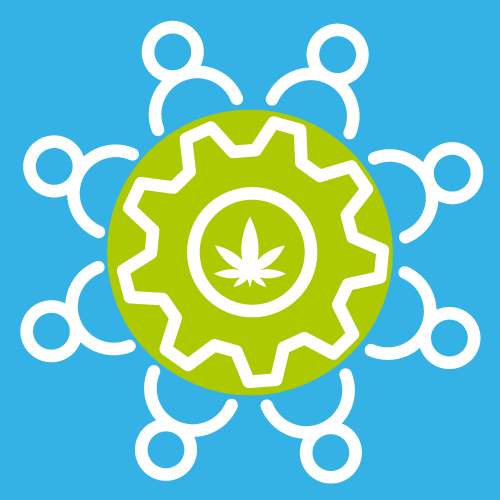The pace and scale of change in the cannabis industry today has had unprecedented growth – and there are definitely NO signs of it slowing down anytime soon.
Why A Learning Culture Is The Answer
- Roughly 3.5 billion people today own a smartphone and the number of internet users around the world has GROWN by over 1.9 billion people in the last five years alone (that’s more than 75% growth) according to HootSuite.
- It’s predicted by World Economic Forum that machines could displace 75 million jobs across the globe by 2022, while 133 million new roles could EMERGE from the evolving division of labor between humans and computers.
- Probably for the first time in history, according to Forbes, we are seeing five (5) generations in the workplace at the same time." EACH of those generations has different expectations of society and companies, as well as different ways of working.

In this context, it’s clear that globalization, accelerating technology changes, and the cocktail of new generations in the workforce, are disrupting the workplace and transforming the nature of work. What’s the solution? It lies in reshaping the way we think about learning and developing a culture of learning within the business. Not just any learning culture; the kind of culture that focuses on empowering employees and helping businesses adapt to change; a necessity to succeed today and in the future cannabis industry.
Mind Your Cannabis Industry Skillset Gaps

- 79% of employers believe there is a skill gap (PricewaterhouseCoopers).
- 54% of all employees will need reskilling per the World Economic Forum.
- 80% of employers say soft skills are increasingly important stated by LinkedIn.
- 57% struggle to assess soft skills accurately as observed by Forbes.
- 10% of employers feel ready to face the skill shortages reported by Deloitte.
The digital era has opened up a lot of new doors for businesses. In just the last thirty years, technological advances have helped almost double global productivity according to the World Economic Forum. But it also puts incredible PRESSURE on organizations and employees. Keeping up with the rate of constant digital change can be difficult, particularly given the recent rise of artificial intelligence, virtual reality, and machine learning, which bring with them the need for new cannabis industry jobs with technical skills.
PricewaterhouseCoopers report found 79% of employers believe there is a skill gap in their company today, while according to the World Economic Forum 54% of all employees will need reskilling by 2022. And in a world dominated by technology, soft skills such as creativity, persuasion, collaboration, adaptability, and time management are also becoming a CHALLENGE for employers:
- Despite 80% of employers saying that soft skills are increasingly important per the World Economic Forum.
- 57% struggle to assess soft skills accurately in their organization stated by Forbes.
- 89% state that bad hires typically lack soft skills as observed by PricewaterhouseCoopers.
Not only there is a skills gap, but there is also a new fast skills obsolescence – a skill learned today will be about half as valuable in just five (5) years or less. While 86% of employers, aware of the high costs of recruitment and challenges of finding the right talent, find learning and development highly important reported Deloitte, ONLY 10% of them feel ready to face the skill shortages stated by LinkedIn. Employers need to build and maintain critical skills in their existing workforce if they want to keep up with the world.
Continuous Company Learning Culture
- 94% of employees say they would stay longer if it invested in their training.
- 20% believe “the inability to learn and grow” makes them look for another job.
- 19% of employees consider the “opportunity to learn and grow” a top reason that inspires them, makes them happy, and want to work much harder.
- 47% are less likely to be stressed if they train five (5) hours each week.

In this rapidly changing digital world, not only is learning key to organizations and employers but it is also increasingly important to employees. Learning opportunities are among the largest DRIVERS of employee engagement and strong workplace culture – 94% of employees say they would stay at a company longer if it invested in their learning and development as reported by LinkedIn.
Learning is as much a driver for inspiration, happiness, and engagement at work as it is a reason for employees to leave a company in the cannabis industry that doesn’t provide learning opportunities. While 19% of employees consider the “opportunity to learn and grow” as the TOP reason that inspires them, makes them happy and want to work harder stated by the World Economic Forum, and 20% of employees believe “the inability to learn and grow” would make them look for another job as reported by Deloitte’s study.
Happy, ENGAGED employees are better workers, and the links between happiness and learning are clear – 47% of employees are less likely to be stressed at work if they learn more than five (5) hours a week reports LinkedIn. Engaged employees are more fulfilled, more likely to increase customer satisfaction levels, and more likely to be innovative and productive. Nowadays, successful companies are those who learn fast, learn well, and learn all the time. Put simply, learning directly affects the bottom line. According to a recent Deloitte study, high-performing learning organizations that are developed in the cannabis industry will be the ones who:
- 46% More Likely to Be First to Market
- 37% More Productive
- 92% More Likely to Innovate
- 58% More Likely to Meet Future Demand
In fact, learning at work is not just a “nice to have” for employees, it has become CENTRAL to their employee experience – the way they feel, the way they engage, and ultimately the way they perform. And that’s a winning situation that every business wants.
Employees Learning On Their Terms

Make training personal for your employees and GIVE them ownership of it:
- 71% of employees want to choose where and when they train reports Kineo.
- 74% of employees want to learn during their spare time at work reports LinkedIn.
- 68% of employees say they would pick up skills faster if they had more direct control over the pace of workplace learning as researched by LinkedIn.
- 38% of employees from all generations want a fully self-directed and independent learning experience too as reported by LinkedIn.
While continuous learning culture is CRUCIAL for the success of organizations and for the engagement of the people within those walls, it’s not a one-size-fits-all for employees. Similar to the way they interact with technology in their personal life, employees have the same expectations at work. They want to have more control over their learning – 71% of employees want to choose where and when they are taking training and 74% want to learn during their spare time at work as reported by LinkedIn. So what does that mean?
In a nutshell, they want to decide what they want to learn, when they want to learn, and how they want to learn – 68% of employees say they would pick up skills faster if they had more direct CONTROL over the pace of workplace learning states Kineo. On top of self-selected experiences, they want guided learning where curated content will help them learn what’s relevant to their working experience; 38% of employees from all generations want fully self-directed and independent learning as researched by LinkedIn.
Life is busy, and employees want to fit learning around their life. Personalizing learning means making learning genuinely EASY to access, available in a variety of formats from video to text, and suited to all devices. Successful implementation of a continuous learning culture doesn’t just rest on making learning available; learning needs to be available how, when, and where employees want.
Improving Employee Training Experience
- 74% of employees access resources from their smartphones to do their jobs.
- 57% of employees prefer accessing learning modules on the go.
- > 50% of employees value the ability to collaborate with their peers.
Changing technologies and digital behaviors aren’t just DRIVERS of the need to shift our thinking about workplace learning; they’re also central to the solution. Today, employees are challenging employers to use technology and improve the experience.
In our current “always on the go,” “always connected” and hyper-social smartphone world, employees expect their workplace to DELIVER the same kind of experience – 57% of employees prefer accessing learning modules on the go stated by Kineo and 74% access resources from their smartphones to do their jobs reports Deloitte. Let’s start reshaping your organization to be one that’s learning-centric by adapting to the needs and wants of your employees who will be working for you in the cannabis industry.

And in today’s digital world, social learning is a key requirement from employees; more than half of employees VALUE the ability to collaborate with instructors and/or other learners reported by LinkedIn. Social and mobile experiences aren’t just for cat videos and funny gifs. They have become critical of how employees consume information, interact with one another, and learn. Put simply, these technologies and behaviors have become fundamental to the learning experience. Without them, companies will be left behind.
Five (5) Company Learning Culture Rules

Here are practical steps to EVOLVE employee learning and support continuous training:
- Lead: Changing culture starts at the top. You need genuine buy-in from your executive leadership not only to support continuous learning but to also advocate for it. The investment and encouragement from team leaders will generate buy-in to the initiatives from all of your employees.
- Assess: Take a detailed look at the skill gaps in your organization. Empower your managers to take a deep dive into their operational resources and abilities and analyze their responses. Encourage managers to converse with their teams, and build a training plan tailored to each individual employee’s needs.
- Plan: Develop well-planned programs that not only identify learning needs but include measurements of learning outcomes. Building a timeline, setting goals, and allowing your employees some time to work on themselves, is all part of the plan.
- Engage: Engage with staff to participate and give feedback. Consider encouraging user-generated content as part of your programs. Subject Matter Experts (SMEs) bring great engagement and typically lead to greater team learning success.
- Adapt: Remember training needs to be easy and not one-size-fits-all. Instead, adopt traditional approaches to suit the digital age. Consider online learning, the use of smart devices, apps (including offline learning), and social platforms to adapt to your employee’s style of living and learning. Have enough flexibility to optimize learning and ensure positive outcomes.
What’s Next & Continuous Learning
Change is constant. The only thing that stays the same is our NEED to upskill to keep up with the rate of change. In this new landscape with new technologies and new digital behaviors, the key challenge for businesses today is – how to offer a complete, very coherent, and continuous training experience in the cannabis industry.
The first step is, of course, understanding the skills GAP within your organization. Then, implement a culture of continuous learning with technology that empowers employees to learn on their own terms, in a personalized, adaptable experience that can be both mobile and social. Learning matters to employees and it helps businesses grow fast.
The type of learning culture you have in your business IMPACTS every facet of your organization – from productivity to retention, from innovation to customer service, and beyond. In this fast-accelerating world, investing in and building a strong learning culture is the difference between keeping up – or being left behind – then starting the conversation about continuous learning in your workplace.



